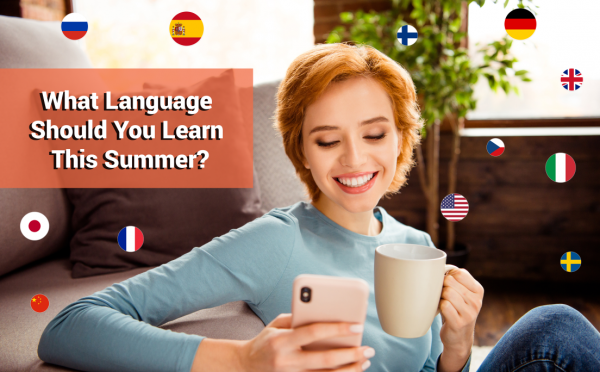4 Reasons Why You Should Learn a Language In Your Forties (40s)
Learn a Language In Your Forties - Learning a new language at this age has different challenges that when you were in your 20s or
Wakey-wakey! Let’s start the day right.

Every day it’s a fresh start. Why not treat it properly? If you’re traveling to many different countries, it can prove useful to know how to say “good morning” in different languages. Starting the day with a smile and greeting those around you can boost your mood and the way people relate to you. Here’s how to say “good morning” in the 10 of the most popular languages on Earth:
Good morning is – along with hello – one of the most common travel words around the world. Nothing breaks the cultural ice like a respectful greeting in the local language. This is why the ability to say good morning in different languages is a life skill that is well worth learning. Let’s dive in!
Learning to say “good morning” in different languages can be a fascinating and rewarding experience. Not only can it help you connect with people from diverse cultures, but it can also broaden your understanding of the world and its many languages. With over 7,000 languages spoken globally, there’s no shortage of opportunities to learn and explore. In this article, we’ll delve into the world of morning greetings, exploring how to say “good morning” in various languages, including some of the most widely spoken languages in the world.
Buenos días literally means “good days”, but it is used to say “good morning” in Spanish. Suitable for all social contexts, this greeting can be used with both friends and strangers. If you want to mix things up, you can also add hola and say “hola, buenos días” as it is a very standard and friendly salutation. If you want to say goodbye in the morning, you can say “adiós, buenos días” which is a nice way to wish someone a good day.
It is also important to note that in some countries from South America it’s common to say “buen día” which is literally the singular form of “buenos días”. However, if you go to Spain, it’s best to stick with “buenos días”. Additionally, similar to the Polish ‘Dzień dobry,’ ‘buenos días’ can also be used to mean ‘good afternoon’ in some contexts.
Remember this: in European French, there is no exact translation for the phrase “good morning”. Therefore, in France, you should always use “bonjour” instead of “bon matin” if you want to say “good morning” in French. ‘Bon matin’ is the literal translation of ‘good morning’ but is not commonly used in European French.
On the other hand, in Quebec, “bon matin” is the preferred greeting usually until around 10 or 11 a.m.
Both “bonjour” and “bon matin” are appropriate in both formal and informal settings and can be used with friends and strangers alike.
To say “good morning” in German, you can use the phrase “Guten Morgen”. This is a common and polite way to greet someone until noon. It can be used with both friends and strangers which makes it appropriate in both formal and informal social contexts. The phrase ‘Guten Morgen’ is how you greet good morning in German.
As you probably know, Germans like to be efficient, so sometimes greetings tend to be kept short. Therefore, in informal situations, you can simply say “Morgen!”.
Everyone is familiar with the Italian “ciao” which means “hi”. It has become so popular, that it is often used between friends in countries all around the world. However, if you want to say “good morning” in Italian, the word you are looking for is “buongiorno”.
Literally meaning “good day”, “buongiorno” can safely be used in all kinds of social contexts from morning until after lunch.
In Portuguese, “bom dia” is how you say “good morning”. Literally translated as “good day”, this greeting is commonly used between the hours of 5:30 a.m. and 12:00 – 1:00 p.m.
It’s important to note that the pronunciation of “bom dia” may vary depending on the country. In Brazil, it is pronounced “bom GEE-a”, while in Portugal it is pronounced “bom DEE-a”.
Learn how to say “good morning” in over 40 languages with Mondly! 👇
To say “good morning” in Russian, you can use the phrase “доброе утро” which is pronounced “Dobroye utro”. This is the most popular way to greet people in the morning.
Like all morning greetings on this list, “доброе утро” can safely be used in all kinds of social contexts with both friends and strangers.
Additionally, if you want to go the extra mile, it is considered polite to ask about the person’s well-being after greeting them. For example, “как дела?” (kak dela?) which means “how are you?” is often used in conjunction with “доброе утро” (dobraye utro). This makes the greeting more friendly and personal.
早上好 (Zǎoshang hǎo) is how you normally say “good morning” in Mandarin Chinese, the most spoken language globally. However, if you want to keep it short and sound more like a native, you can just simply say 早 (zǎo)
The same as the English “good morning”, 早 (zǎo) can be used in most social settings provided it’s morning, of course.
When greeting someone in the morning hours before 10:00 a.m. in Japanese, おはようございます (Ohayōgozaimasu) is the most appropriate choice. It is considered more formal than こんにちは (Konnichiwa) or “hello” and is safe to use with people you are not familiar with or in formal settings such as with your boss or teacher.
In addition to being used as a way to say “hello”, おはようございます (Ohayōgozaimasu) can also be used as a way to say “goodbye”.

In Korean, the phrase “좋은 아침이에요“ (joh-eun ah-chim-ee-eh-yo) is used to greet someone in the morning. This phrase is a polite and formal way to say “good morning,” and it’s commonly used in both personal and professional settings. The phrase is composed of three words: “좋은“ (joh-eun), meaning “good,” “아침” (ah-chim), meaning “morning,” and “이에요“ (ee-eh-yo), which is a polite suffix used to show respect.
In Hebrew, the phrase “בוקר טוב” (boker tov) is used to greet someone in the morning. This phrase is a common way to say “good morning” in Israel and other Hebrew-speaking countries. The phrase is composed of two words: “בוקר” (boker), meaning “morning,” and “טוב” (tov), meaning “good.” Hebrew is an official language of Israel and is spoken by over 9 million people worldwide.
The most common way to say “good morning” in Arabic is صباح الخير (Sabah alkhayr). Arabic is one of the official languages in many countries, making ‘صباح الخير’ a widely recognized greeting. The usual response to this is صباح النور (Sabah an-noor) which means “morning of light”. Isn’t that just beautiful?
Other morning greetings in Arabic include يسعد صباحكم (Yaseed sabahkom) which translates to “may you have a nice morning”, صباح الياسمين (Sabah al Yasmine) meaning “a morning full of jasmine”, and صباح أل عشت (Sabah al ishta) which is “a morning full of cream”.
Careful though! As beautiful as they sound, these last examples can only be used with friends or people who are very close to your heart.
To say “good morning” in Hindi, you can use the phrase सुप्रभात (Suprabhaat). This is a common and polite way to greet someone in the morning and it is appropriate for both formal and informal settings.
If you want to ask about the person’s well-being after greeting them, you can add क्या हाल है? (kya haal hai?) which means “how are you?”.
Easy enough! The most straightforward way to say “good morning” in Romanian is “bună dimineața”. While the diacritics may look weird, they are quite easy to pronounce. You will pronounce “ă” like “uh” or the last sound in the word “the”. “Ț”, on the other hand, is similar to the sound you make when you say “ts”.
If you’re meeting a close friend and want to sound more like a native, you can just say “neața”.
Learning to say “good morning” in different languages can have numerous benefits. For one, it can help you connect with people from diverse cultures and backgrounds. It can also broaden your understanding of the world and its many languages. Additionally, learning morning greetings can be a fun and engaging way to learn a new language. By learning to say “good morning” in different languages, you can:
In conclusion, learning to say “good morning” in different languages can be a rewarding and enriching experience. By exploring the various ways to greet someone in the morning, you can broaden your understanding of the world and its many languages. Whether you’re a language learner, a traveler, or simply someone interested in culture, learning morning greetings can be a fun and engaging way to connect with others and enhance your language skills. So why not start your day with a smile and a greeting in a new language?
Do you want to learn languages fast? Try Mondly, the award-winning language app that can help you master languages in record time.
Instead of tiring yourself for hours with inch-thick textbooks, slip a 10-minute Mondly lesson into your routine and make learning a breeze. You will learn languages naturally using:
Start using Mondly for free on your computer or download the app and learn languages anytime, anywhere.

Learn a Language In Your Forties - Learning a new language at this age has different challenges that when you were in your 20s or

New year, new you, new language? 🎆

Is it Spanish? French? German? Or maybe Japanese? Take this quiz now and find out what language you should learn this summer.